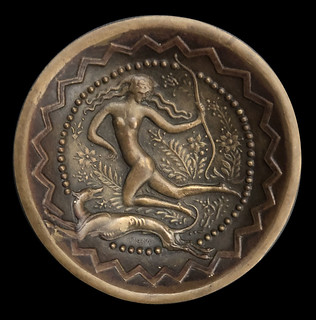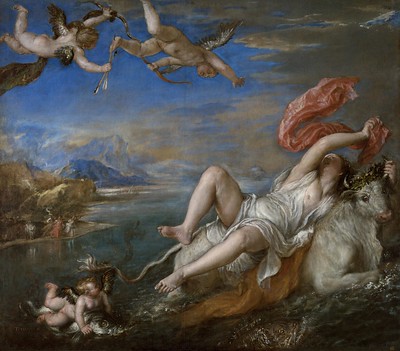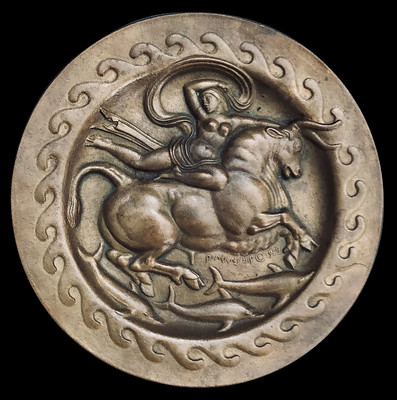
PREV ARTICLE
NEXT ARTICLE
FULL ISSUE
PREV FULL ISSUE
MANSHIP'S DIANA AND FLIGHT OF EUROPABob Mueller submitted this article on the works of artist Paul Manship. Thanks! -Editor
From Medals to Monuments
First and foremost, I would like to dedicate this submission to the memory of Dick Johnson and Joe Levine, whose recent passing within two months of each other has been heavy on my heart and left a palpable void in the medallic art community. The current exhibition "Paul Manship: Ancient Made Modern" at the Wadsworth Atheneum focusing on his artistic development is the impetus for this brief essay, since, as pointed out in the last issue of The E-Sylum, his medallic work was basically overlooked. In fact, two of Manship's most popular sculptures can trace their beginnings to "medallic" works by the artist. Both of these found their beginnings in what the late Sam Pennington coined as "medallic ashtrays." The first, Diana, from the pair Diana and Actaeon was cast in several sizes from moderate to monumental. Though only one half of the pair, the origin of this goddess can be traced to the earliest of Manship's bronze plates executed in 1915. The National Sculpture Society commissioned the artist to create a small bronze ashtray to be presented to its lay members, which numbered 145 at the time. Manship's choice of the goddess Diana resulted in a delightful gem in that became the first of a series illustrating mythological scenes and astrological signs.
The hound in comparison exudes pure physical power. Its musculature is clearly defined and we can feel the strength and lightning speed of this magnificent beast as he adoringly races at his mistress' side. Both are encircled, but not completely contained within a raised beaded border forming a divine mystical nimbus; lending the illusion that they might at any moment leap from the confines of the bowl. This border is then contained within a second zig-zag motif just inside the rim, adding even more energy to this dynamic composition. Around the outside rim of the bowl runs the inscription, the lettering of which is well designed and quite creative. It reads "FROM•THE•NATIONAL•SCULPTURE• SOCIETY•TO•ITS•LAY•MEMBERS• MCMXV." The piece is signed around the base PAUL MANSHIP•SC•©, and is also signed inside the bowl •PHM• making this only one of two works to be signed on both sides by the artist. Each example was cire perdu cast by Roman Bronze Works as indicated by a seal stamped into the base of the bowl.
The relocation to Paris energized the sculptor as he wrote to his friend Barry Faulkner: "Paris is the center of the world—and while I am not in the center of the whirlpool I feel the motion of it;" and later "My coming here is no mistake—I feel inspired to go ahead—and I hope to see my own ideas more clearly and to carry out my work in better form." 1 John Manship wrote in his father's biography: "the most important pieces that Manship did during these Paris years were the Diana and Actaeon.... These pieces represent Manship at his most characteristic, with their use of mythological subjects, nude figures in motion, stylized animals and plants, and highly decorative patterns in which the voids are as calculated for effect as the solids. These two pieces have always been—along with Dancer and Gazelles—Manship's most popular works." 2 The other work to find its genesis in the humble and utilitarian form of an ashtray was The Flight of Europa of 1925. Isabel Stewart Gardner, the grande dame of Boston society, owned Titian's 1562 masterpiece, Rape of Europa, which inspired the sculptor to create the Flight of Europa Ashtray in 1917 for her. The sculptor met the heiress through a mutual friend, Denman Ross, and presented her with one of his Jeanne d'Arc medals as a gift. In response she wrote an effusive letter to the artist: "I carry it around with me everywhere, my ‘paperweight.' Looking at it and feeling it give me so much pleasure. Oh it is too beautiful! Jeanne d'Arc is one I love and this is the best of her I know... I do not need a reminder of you, whom I have so near my heart. May the future bring us oftener together." 3
"Mrs. Manship joins me in wishing you the very best of Merry Christmases. And are sending you this little tray as a trifling remembrance of your many kindnesses to us... Mr. Titian has proved that Europa & the Bull is a great subject. This relief is to try out the subject for composition. How do you think it will work out in the round, I want to try it." 4 It appears clear that Manship's intent was to work this ‘sketch' into something more definitive, and it would not be until 1925 that he realized this thought with his Flight of Europa. The work is a successful composition but fails to capture the sensual energy and excitement of the abduction as does the earlier bronze dish. In contrast to Diana, Europa appears a bit campy, as she listlessly sits atop the bull with Eros whispering in her ear. The leaping dolphins are paired here and emphasize motion, as well as the fully extended bull, adding to the sense of speed and excitement. In his catalogue raisonné on the artist, Edwin Murtha included this notation for the work: "Manship's Flight of Europa is very likely Minoan in inspiration, yet his strong personal style has produced a wholly original work. it is interesting to compare his version of the subject with those of his contemporaries [Antoine] Bourdelle and [Carl] Milles. Bourdelle's little sketch is a work of considerable power despite its size. Milles bronze Europa and the Bull vibrates with drama and nervous movement, the very opposite of the understated mood of Manship's piece. The story of Europa and the Bull, something of an impious parody on the weaknesses of the gods, receives in Manship's version the light touch and restrained humor it needs." 5 The Europa Ashtray was a piece that saw several incarnations throughout Manship's career. By 1919, while retaining the same basic composition, the piece had already evolved into something resembling its final state. The most noticeable changes are the absence of the dolphin on the far right, the strengthened tail flukes of the remaining three and the forward thrusting horns of the bull, which now break free into the encircling wave motif. The dish still retains some archaic qualities but the modeling is less stylized and more naturalistic, lending a softer and more sensual appearance. In 1946, Flight of Europa achieved its final state with slight refinements in the modeling and the inclusion of an additional fold in the drapery over Europa's thigh. There are themes that run through Manship's corpus of work—especially Pegasus—who appears on a number of medals, large reliefs and sketches, though none form the inspirational basis for a major work. Each is an expression unto itself. The two works examined here literally "rise from the ashes" to give us a look into Manship's creative process; ascending from humble beginnings to stand today as an enduring testament to his genius.
Notes:
1 Manship, John; Paul Manship; Abbeville Press, NY, 1989 p. 97
To read the earlier E-Sylum article, see:
Wayne Homren, Editor The Numismatic Bibliomania Society is a non-profit organization promoting numismatic literature. See our web site at coinbooks.org. To submit items for publication in The E-Sylum, write to the Editor at this address: whomren@gmail.com To subscribe go to: https://my.binhost.com/lists/listinfo/esylum All Rights Reserved. NBS Home Page Contact the NBS webmaster 
|







